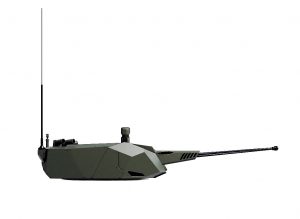
Cockerill 1030: lightweight 30×173 mm firepower from John Cockerill Defense
Among the many cannons that John Cockerill Defense (JCD) installs on its numerous manned and unmanned turrets, Northrop Grumman’s Mk44S is definitely the best seller with over 600 units fitted to JCD products, the 30×173 mm calibre having become a standard in infantry fighting vehicles in the last years. The Belgian company portfolio already includes one system capable to host that cannon, such as the Cockerill 3030,however JCD unveiled a new development during the 2021 edition of IDEX, bringing to Abu Dhabi a full-scale mock-up of its new Cockerill 1030, a remotely controlled turret dedicated to the Mk44S chain gun. “The reason behind the development of the Cockerill 1030 was to add to our portfolio a turret specifically designed for 30×173 mm and 40×180 weapons to be mounted on 6×6 and 8×8 armoured vehicles that cannot manage the payload of our Cockerill 3030 manned turret,” Thierry Renaudin, John Cockerill CEO tells EDR On-Line. “It uses common features from the CPWS in terms of electronic architecture, while it benefits at the same time from our experience with the Cockerill 3000 platform, which has been manufactured in nearly 600 examples,” he adds.

The turret structure is made of welded ballistic aluminium and provided a Level 2 protection according to STANAG 4569, however this can be increased to Level 4 thanks to an add-on armour kit. At the basic protection level the Cockerill 1030 has a mass short of 1,500 kg, and can thus be easily fitted to all 6×6 and 8×8 armoured vehicles, also thanks to the small diameter of the turret ring, which is only 1.5 meters.

On the right of the main gun we find the 7.62 mm coaxial machine gun; in its standard configuration the RWS is fitted with eight smoke grenade launchers installed at the back on the right and left sides of the turret. The dual ammunition feed can host up to 200 ready rounds. The optronic suite is fitted on the left of the RWS; encased in the structure in order to maximise protection, we find the gunner sight, while on top of the turret a 360° panoramic sight is available to the commander, the Cockerill 1030 being available both in one-man and two-man controls configurations. In order to cope with the UAV threat, maximum elevation is 10° higher than that of the other JCD products hosting an Mk44, the elevation arc of the Cockerill 1030 being –10°/+70°.

The new JCD product leverages the developments in vetronics carried out in the recent past by the company, hence it is fitted with the same open architecture vetronics adopted on the CPWS Gen.2, that allows easy integration of third parties subsystems, such as optronics, antitank missiles, rocket launchers, smoke grenade launchers, active protection systems, acoustic gunshot detectors, 360° close surveillance systems, and others. While being subsystems agnostic, JCD considers that the optronic suite must provide a minimum detection range of 7 km, recognition range of 4.2 km and identification range of at least 2.2 km.

The Cockerill 1030 top configuration would include Level 4 protection and antitank missiles, JCD not providing the overall mass in that configuration for the time being. However when minimum mass is required, such as i.e. on amphibious vehicles, the new JCD RWS can be stripped of its ballistic protection, the ammunition load reduced to 150 rounds, so that its mass is even lower than the aforementioned one. JCD is also ready to consider low cost options for potential customers with tight budgets, who require however a reliable turret with good firepower, that can be eventually upgraded at a later date.
As said JCD is currently developing the Cockerill 1030, which should be available in mid 2021. “We are building the demonstrator as we speak,” the company CEO confirmed, “and, COVID permitting, it will be firing in a couple of months.”
Images and photos courtesy John Cockerill Defense



